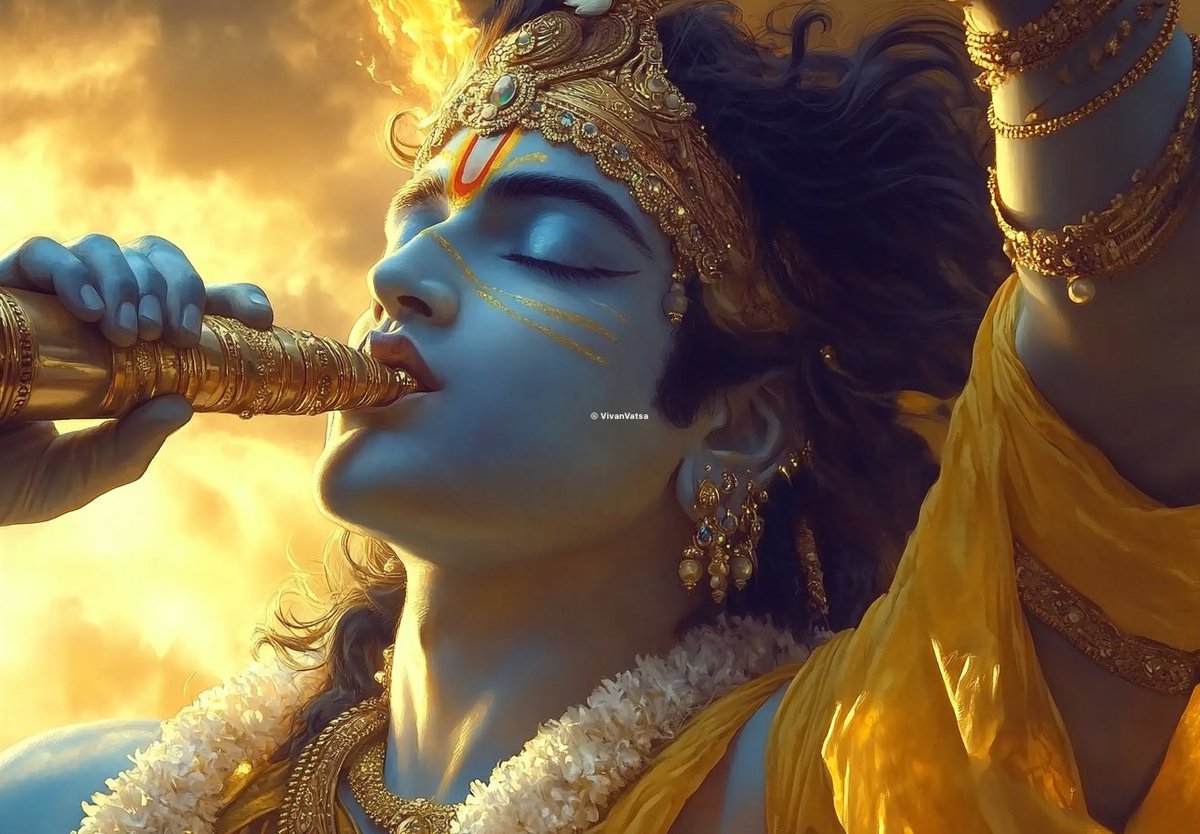What’s this weird shaped TRUMPET that Shri Krishna blew in Kurukshetra War? This sacred Hindu 'Tool' TRIGGERS a lot of EXTREME religious intolerant groups in India; It produces the sound of ॐ (Om). Every Unapologetic Hindu blows this in 'Aartis', and it’s called a “Shankha”…

शंख Shankha. Vishnu Ji’s sacred symbol. One of the anmol Ratan from Samudra Manthan. This is the story of Sanatan History of “Shankha”…

The historical story of the shankh dates back to ancient times described in the Puranas. During the great cosmic event known as the Samudra Manthan, or the churning of the ocean of milk, the devas (gods) and asuras (demons) sought the nectar of immortality, Amrita.


Devtas and Rakshas used Mount Mandara as the churning rod and the serpent Vasuki as the rope. From this manthan came a lot of Ratnas. Among these treasures was the shankh, symbolizing the primordial sound and the essence of creation.

The shankh is considered the embodiment and true representation of Sanatan Dharma because it signifies the origin of existence itself. Its spiral shape represents the infinite cycles of life, death, and rebirth, mirroring the Hindu belief in samsara, the continuous cycle of

The clockwise spiral of the shankh is also said to represent the expanding universe, reflecting the cosmic dance of creation and dissolution. The sound produced when the shankh is blown resonates with "Om," the sacred syllable considered the sound of the universe. This connection



In Hinduism, the shankh holds immense power. It is believed to possess the ability to purify the environment, dispel negativity, and attract divine energies. Blowing the shankh during rituals and ceremonies is a common practice, as it sanctifies the surroundings and invites the

Ancient Hindu scriptures such as the Puranas, the Bhagavad Gita, and the Mahabharata highlight the significance of the shankh in a Hindu's life. In the Mahabharata, the shankh plays a pivotal role on the battlefield of Kurukshetra. Before the commencement of the great war,

The Mahabharata describes the various conch shells of the Pandava brothers and Krishna Ji. Yudhishthira blew the Anantavijaya, Bhima blew the Paundra, Arjuna blew the Devadatta, Nakula and Sahadeva blew the Sughosha and Manipushpaka, respectively, while Krishna Ji blew the


The prime reason for the shankh being a symbol of Hinduism lies in its representation of the eternal truths and cosmic principles that underpin Sanatan Dharma. It is a tangible manifestation of the divine sound and the cyclical nature of existence.

Vishnu Ji's relationship with the shankh is deeply rooted in his role as the preserver and protector of the universe. Often depicted holding the shankh in his upper left hand, Vishnu Ji uses it as a symbol of the divine sound that creates and sustains the cosmos. The shankh,

According to the Puranas, the story of Panchajanya is significant. A demon named Panchajana had kidnapped the son of Sandipani, Krishna Ji's guru. To rescue the child, Krishna Ji confronted Panchajana, who had taken the form of a conch shell and was hiding in the ocean. Krishna


Krishna Ji, an incarnation of Vishnu Ji, is intricately involved with the shankh. In the Mahabharata, Krishna Ji serves as Arjuna's charioteer and guide. Before the battle begins, Krishna Ji blows his conch shell, Panchajanya, instilling confidence in the Pandava army and

The shankh holds immense power in the entire universe as it represents the primordial sound and the vibrational energy that sustains creation. Its resonance is believed to align the chakras, balance the energies within the body, and connect the individual with the universal

The shankh's influence is also evident in Hindu cosmology and philosophy. It is associated with the element of water, one of the five fundamental elements (pancha mahabhuta) that constitute the universe. The shankh's connection to water signifies its role in sustaining life, and


For Hindus, the shankh is a symbol of their rich spiritual heritage and a conduit for connecting with the deeper aspects of their faith. Its presence in rituals and its depiction in sacred art reinforce its role as an integral part of Hindu culture and spirituality. The shankh's

The shankh's enduring relevance in contemporary times highlights the timeless nature of its symbolism. In an age where materialism and external distractions often overshadow spiritual pursuits, the shankh serves as a reminder of the inner journey and the importance of cultivating



For Hindus, the shankh is more than an artifact; it is a living symbol of their faith and a reminder of their place in the cosmic order. Its sound continues to resonate through temples and homes, echoing the timeless wisdom of Sanatan Dharma. The shankh embodies the eternal

The shankh's story, its connection to Vishnu Ji and Krishna Ji, and its profound significance in Hinduism underscore its importance as a symbol of Sanatan Dharma. It serves as a bridge between the material and spiritual worlds, a tool for personal and collective transformation,


Indian history is filled with such grand stories, never to be forgotten. We @iKyu_HQ worship the delicacy of history in India and stand to flourish it to the world... Our handKrafted documentary-style breakdowns are ready! Experience us at
Follow @VivanVatsa for more doses of brutal breakdowns, history, research and philosophy.
What’s this weird shaped TRUMPET that Shri Krishna blew in Kurukshetra War?
— vivan. (@VivanVatsa) October 21, 2024
This sacred Hindu 'Tool' TRIGGERS a lot of EXTREME religious intolerant groups in India; It produces the sound of ॐ (Om).
Every Unapologetic Hindu blows this in 'Aartis', and it’s called a “Shankha”… pic.twitter.com/B8ecqvi2tS

